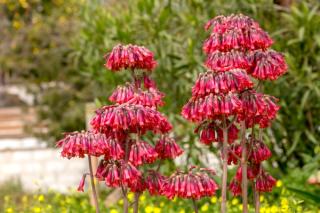Climate unpredictability has always been a challenge to grazing livestock industries in Australia. Many important poisonous plants in Australia are highly adaptable to the effects of climate change. In this article we explore some of the risk, solutions and how SLR can help.
Climate unpredictability has always been a challenge to grazing livestock industries in Australia. The initial solution to poor conditions in an era before cheap bulk transport: walk and graze the livestock to places where conditions were better, also known as Travelling Stock Reserves (TSR).
TSRs have now largely been replaced by land transport but are still used for:
- Long-term grazing
- Water resources
- Conservation
Strategic geographic relocation of livestock is still a legitimate strategy and in an era of climate change is likely to become more important because:
- It works if it is managed correctly
- It can be economically worthwhile if there is sufficient capital investment
- The best way to protect livestock (economics and animal welfare) is to relocate them to places where conditions are good
Poisonous plants and relocation of livestock
Greater than 1,000 species of Australian plants have been demonstrated to be toxic to grazing livestock. This is not a new problem: it has been recognised as a problem ever since the start of the TSR network.
The problem continues to occur: strategic relocation of livestock will continue to be key to managing climate variability that is being magnified by climate change.
Risk factors
Australia is faced with the following risk factors:
- The combination of hungry, tired, cold, or stressed animals and a lack of familiarity with the local flora has been a common cause of plant poisoning in Australia.
- Many important poisonous plants in Australia are highly adapted to drought and fire.
- Often, poisonous species are the last plants to disappear during the early stages of a drought and are the first to appear after the drought breaks.
- Often, poisonous species are the first to appear following fire.
- The very short nature of many important plant poisonings in Australia:
- Poisonings by many species may disappear for years, only to “suddenly” reappear when climatic conditions are appropriate.
- Loss of knowledge and experience of:
- How to avoid
- How to prevent
- How to predict
- How to diagnose
- Because cases are rare “most” of the time, they go unrecognised and unreported.
- Because cases are rare “most” of the time it is difficult to economically justify surveillance and diagnostic systems leading to a loss of expertise and training.
Common and important plants may become toxic under the right conditions
Due to changes in climatic conditions, there may be an increase in the following:
- Plant stressors
- Insect damage and other predation
- Plant damage
This may result in the following increased key risks to livestock health:
- Increased risk of cyanogenic glycoside poisoning (due to acute and chronic thiocyanates)
- Increased risk of nitrate/nitrite poisoning
- Increased risk of mycotoxins (especially aflatoxins, Fusarium mycotoxins, new mycotoxins e.g., November disease)
Apart from limited data and modelling for mycotoxins, there are little data or modelling on the effects of climate change on:
- The occurrence of poisonous plants
- Levels of toxins in poisonous plants
- Distribution and incidence of highly poisonous individual plants within a population
What are some solutions?
Provision of sufficient safe and palatable food
- Can be very hard to implement
- Does not answer everything: some important poisonous plants are highly palatable
- Some individuals “develop a taste” for poisonous plants
- Application of herbicides can make poisonous plants more palatable
Strategic relocation of livestock
- Not without its risks and problems
Drought feeding using native plants
- Mulga is the classic (Acacia aneura complex) – but it’s not without its problems (e.g. nutritional melanosis in liver and kidneys in sheep and goats). Key advantages of using native plants are that they are readily available, they generally retain their nutritional value, and can be cheaply supplemented (non-protein nitrogen, molasses etc.).
- This strategy can be combined with feed lotting to restrict movement (i.e. reduce caloric expenditure).
- Such an approach requires knowledge and experience to implement.
- A disadvantage of using native plants is that they may not necessarily be that palatable to livestock, thus one may need to coat, spray or supplement the feed.
What will climate change do to coping with drought?
Impacts of climate change on strategic relocation may include:
- An increased risk of poisonous plants being ingested by livestock
- Strategic locations requiring to be more frequent, rendering the process more expensive
- Perhaps a return to the TSRs?
To cope with climate change, drought feeding using native plants could conceptually be employed as a strategy, but this has the following drawbacks:
- You have to have sufficient stock of plants – could stock size in turn also be affected by climate change?
- Will the plants become more toxic and less nutritious?
- Environmental cost of this may be high as it requires clearing of native vegetation.
Is Australia Ready? Nope!
We have no real idea of the nexus of climate change, poisonous plants and livestock production. There are some untested hypotheses and some experience with drought and drought management, but how effective will this be in the future?
It is reasonable to assume that poisonous plants and mycotoxins may become more challenging to manage in the future.
How can SLR help?
Our Risk Assessment & Toxicology team can assist in understanding the toxicology of native plants to livestock and the risk of harm to livestock from consuming certain flora. Such knowledge can be used to devise appropriate livestock management procedures that are future-proof in terms of the impacts of climate change. SLR can also assist in understanding the toxicology of biocides potentially used to increase feed production, as well as the requirements for registration of new and innovative biocides.
For any further information please get in touch with Dr Rhian Cope or any of our team.




